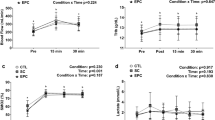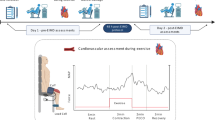Abstract
Purpose
The objective of this study was to assess the effectiveness of graduated compression socks (GCS) on enhancing muscle blood flow and oxygenation during exercise and recovery in healthy subjects.
Methods
Twelve healthy volunteers completed a protocol involving baseline, exercise, and recovery periods with and without GCS. Each test was repeated twice to assess repeatability of the results. The applied sock pressure was measured prior to experimentation using a custom pressure sensing system, and modified as necessary using tensor bandages to control the applied load. During each of the experimental phases, blood velocity in the popliteal artery, calf muscle tissue oxygenation, muscle activity, heart rate, blood pressure, cardiac output, and applied pressure from the sock were measured. Popliteal artery diameter was measured during baseline and recovery periods.
Results
The GCS significantly reduced deoxyhemoglobin (HHb) in the leg during baseline (HHb, p = 0.001) and total blood volume and HHb in the leg during exercise (total hemoglobin, p = 0.01; HHb, p = 0.02). However, there were no differences in leg muscle blood flow velocity or any other variables with and without GCS at baseline, exercise, or recovery. Interestingly, it was found that the local applied sock pressure was very sensitive to the sock application process and, furthermore, the pressure varied considerably during exercise.
Conclusions
No significant changes were observed in measures reflecting oxygen delivery for healthy subjects using GCS during exercise and recovery. Applied sock pressure was carefully controlled, thus eliminating the sock application process as a variable.





Similar content being viewed by others
Abbreviations
- BL:
-
Baseline
- CO:
-
Cardiac output
- DBP:
-
Diastolic blood pressure
- ECG:
-
Electrocardiogram
- EMG:
-
Electromyogram
- EX:
-
Plantar flexion exercise
- GCS:
-
Graduated compression socks
- HHb:
-
Deoxyhemoglobin
- HR:
-
Heart rate
- MVC:
-
Maximum voluntary contraction
- NGCS:
-
Not wearing graduated compression socks
- NIRS:
-
Near-infrared spectroscopy
- O2Hb:
-
Oxyhemoglobin
- ΔP:
-
Applied sock pressure difference from ankle to knee
- ADpop :
-
Popliteal artery diameter
- PBFmean :
-
Mean popliteal artery flow rate
- PBVmean :
-
Mean popliteal artery blood velocity
- REC:
-
Recovery
- SBP:
-
Systolic blood pressure
- tHb:
-
Total hemoglobin
References
Agu O, Baker D, Seifalian AM (2004) Effect of graduated compression stockings on limb oxygenation and venous function during exercise in patients with venous insufficiency. Vascular 12:69–76
Ali A, Caine MP, Snow BG (2007) Graduated compression stockings: physiological and perceptual responses during and after exercise. J Sports Sci 25:413–419
Ali A, Creasy RH, Edge JA (2010) Physiological effects of wearing graduated compression stockings during running. Eur J Appl Physiol 109:1017–1025
Born DP, Sperlich B, Holmberg HC (2013) Bringing light into the dark: effects of compression clothing on performance and recovery. Int J Sports Physiol Perform 8:4–18
Bringard A, Denis R, Belluye N, Perrey S (2006) Effects of compression tights on calf muscle oxygenation and venous pooling during quiet resting in supine and standing positions. J Sports Med Phys Fitness 46:548–554
Buhs CL, Bendick PJ, Glover JL (1999) The effect of graded compression elastic stockings on the lower leg venous system during daily activity. J Vasc Surg 30:830–835
Delis KT, Azizi ZA, Stevens RJG et al (2000) Optimum intermittent pneumatic compression stimulus for lower-limb venous emptying. Eur J Vasc Endovasc Surg 269:261–269
Downie SP, Firmin DN, Wood NB, Thom SA, Hughes AD, Wolfe JN, Xu XY (2007) Role of MRI in investigating the effects of elastic compression stockings on the deformation of the superficial and deep veins in the lower leg. J Magn Reson Imaging 26:80–85
Duffield R, Edge J, Merrells R, Hawke E, Barnes M, Simcock D, Gill N (2008) The effects of compression garments on intermittent exercise performance and recovery on consecutive days. Int J Sports Physiol Perform 3:454–468
Kemmler W, von Stengel S, Köckritz Mayhew J, Wassermann A, Zapf J (2009) Effect of compression stockings on running performance in men runners. J Strength Cond Res 23:101–105
Kumar B, Das A, Alagirusamy R (2012) Analysis of sub-bandage pressure of compression bandages during exercise. J Tissue Viability 21:115–124
Lurie F, Scott V, Yoon H-CC, Kistner RL (2008) On the mechanism of action of pneumatic compression devices: combined magnetic resonance imaging and duplex ultrasound investigation. J Vasc Surg 48:1000–1006
Ma H, Blebea J, Malgor RD, Taubman KE (2015) Variability in leg compression provided by gradient commercial stockings. J Vasc Surg Venous Lymphat Disord 3:431–437
MacDonald MJ, Shoemaker JK, Tschakovsky ME, Hughson RL (1998) Alveolar oxygen uptake and femoral artery blood flow dynamics in upright and supine leg exercise in humans. J Appl Physiol 85:1622–1628
MacRae BA, Cotter JD, Laing RM (2011) Compression garments and exercise: garment considerations, physiology, and performance. Sports Med 41:815–843
McLaren J, Helmer RJN, Horne SL, Blanchonette I (2010) Preliminary development of a wearable device for dynamic pressure measurement in garments. Procedia Eng 2:3041–3046
Mosti G (2012) Compression and venous surgery for venous leg ulcers. Clin Plast Surg 39:269–280
Myles PS, Cui J (2007) Using the Bland-Altman method to measure agreement with repeated measures. Br J Anaesth 99:309–311
Peat J (2002) Health science research: a handbook of quantitative methods. SAGE Publications Ltd, Beverly Hills
Rowell LB (1993) Human cardiovascular control. Oxford University Press, New York
Stein PD, Matta F, Yaekoub AY, Ahsan ST, Badshah A, Younas F, Denier JE (2010) Effect of compression stockings on venous blood velocity and blood flow. Thromb Haemost 103:138–144
Stick C, Jaeger H, Witzleb E (1992) Measurements of volume changes and venous pressure in the human lower leg during walking and running. J Appl Physiol 72:2063–2068
Varela-Sanz A, España J, Carr N, Boullosa DA, Esteve-Lanao J (2011) Effects of gradual-elastic compression stocking on running economy, kinematics, and performance in runners. J Strength Cond Res 25:2902–2910
Vercruyssen F, Easthope C, Bernard T, Hausswirth C, Bieuzen F, Gruet M, Brisswalter J (2014) The influence of wearing compression stockings on performance indicators and physiological responses following a prolonged trail running exercise. Eur J Sport Sci 14:144–150
Villar R, Hughson RL (2013) Effect of altered arterial perfusion pressure on vascular conductance and muscle blood flow dynamic response during exercise in humans. J Appl Physiol 114:620–627
Welman KE (2011) The value of graduated compression socks as a post-exercise recovery modality in long distance models. Ph.D. dissertation, Department of Sport Science, University of Stellenbosch
Wray S, Burdyga T, Noble K (2005) Calcium signalling in smooth muscle. Cell Calcium 38:397–407
Acknowledgments
The authors would like to thank Mr. Ivan Beentjes for designing and constructing the pressure measurement system employed in this study. As well, we would like to thank the Centre for Bioengineering and Biotechnology for initiating and supporting the collaborative work in this study.
Author information
Authors and Affiliations
Corresponding author
Ethics declarations
Conflict of interest
This work was supported by a grant from Lockheed Martin Corporation. Additional support was provided by the Natural Sciences and Engineering Research Council (Operating Grant No. RGPIN6473-07 to RLH, and RGPIN386282-2010 to SDP).
Additional information
Communicated by Massimo Pagani.
Rights and permissions
About this article
Cite this article
Book, J., Prince, C.N., Villar, R. et al. Investigating the impact of passive external lower limb compression on central and peripheral hemodynamics during exercise. Eur J Appl Physiol 116, 717–727 (2016). https://doi.org/10.1007/s00421-016-3331-0
Received:
Accepted:
Published:
Issue Date:
DOI: https://doi.org/10.1007/s00421-016-3331-0




